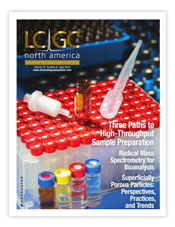In our July issue:
COLUMNS
Column Watch
In-Capillary Sample Concentration in CE
Michael C. Breadmore and Cari E. Sänger-van de Griend
Stacking and sweeping injection methods are compared and practical suggestions are provided about how to enhance sensitivity for charged and neutral compounds. |
 |
LC TROUBLESHOOTING
LC Method Scaling, Part II: Gradient Separations
John W. Dolan
If scaling isocratic separations is so simple, why is gradient scaling so confusing? |
ADVERTISEMENT
Sensitive, Ultrafast GC/MS/MS
The only GC/MS/MS capable of running all triple quad operational modes, without sacrificing sensitivity or accuracy, Shimadzu’s GCMS-TQ8030 elevates this method to a new level of performance. It features a true scan speed of 20,000 u/second and 600 MRM transitions/second. In addition, high-sensitivity ion optics eliminate neutral noise and maximize signal intensity for ultimate S/N ratio.
Learn more |
|
GC CONNECTIONS
The Storage and Use of Gases for Gas Chromatography
John V. Hinshaw
A discussion on the safe storage and use of calibration, carrier, and detector gas cylinders for small or large organizations |
ADVERTISEMENT
Waters introduces the ACQUITY QDa Detector
The future is now separated from the past. Imagine a lab where all analytical scientists
can acquire high-quality mass spectral data. On their own. Within their existing workflows. Across every sample. Without training. Waters imagined just that and introduces the ACQUITY QDa Detector.
Click Here |
|
THE ESSENTIALS
Mixed-Mode HPLC Separations: What, Why, and How
John W. Dolan
The mechanisms of mixed-mode chromatography are explained, with reference to the parameters that are used to optimize selectivity and retention. |
 |
PEER-REVIEWED ARTICLE
Analysis of Amphetamines and Synthetic Cathinones in Hair Samples Using LC–Tandem Mass Spectrometry and Solid-Phase Extraction
Albert A. Elian, Jeffery Hackett, and Kerrie T. Donovan
An efficient method for forensic analysis of amphetamines and synthetic cathinones — the illicit drugs often called "bathsalts" — in hair samples |
Application of Pyrolysis–Gas Chromatography–Mass Spectrometry for the Identification of Polymeric Materials
Peter Kusch, Gerd Knupp, Wolfgang Fink, Dorothee Schroeder-Obst, Volker Obst, and Johannes Steinhaus
This pyrolysis–GC–MS method enables direct analysis of solid or liquid polymers without sample pretreatment, as illustrated here for various materials, including a dental filling material and a car wrapping foil. |
ADVERTISEMENT
Meet the Waters MS Experts and find out more about the technologies that power Waters MS Systems including MSE the engine that drives MS performance, TriWave which gives you the highest selectivity, specificity and experimental versatility, ScanWave for qalitative information when you need it most and StepWave which delivers class leading UPLC/MS/MS sensitivity.
Read more |
|
| |




